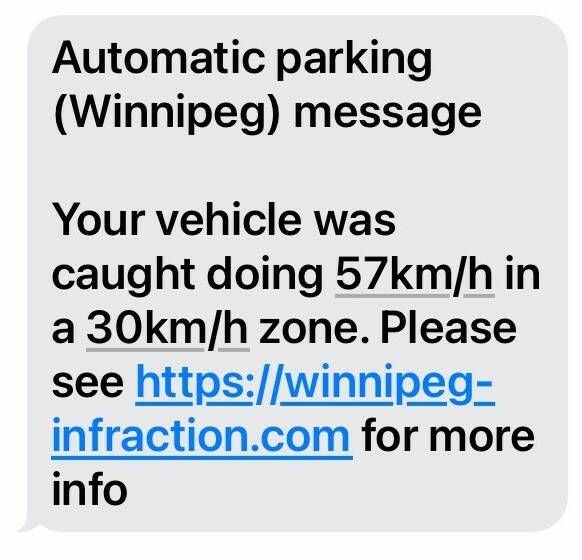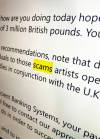The scams just keep on coming
Advertisement
Read this article for free:
or
Already have an account? Log in here »
To continue reading, please subscribe:
Monthly Digital Subscription
$0 for the first 4 weeks*
- Enjoy unlimited reading on winnipegfreepress.com
- Read the E-Edition, our digital replica newspaper
- Access News Break, our award-winning app
- Play interactive puzzles
*No charge for 4 weeks then price increases to the regular rate of $19.95 plus GST every four weeks. Offer available to new and qualified returning subscribers only. Cancel any time.
Monthly Digital Subscription
$4.99/week*
- Enjoy unlimited reading on winnipegfreepress.com
- Read the E-Edition, our digital replica newspaper
- Access News Break, our award-winning app
- Play interactive puzzles
*Billed as $19.95 plus GST every four weeks. Cancel any time.
To continue reading, please subscribe:
Add Free Press access to your Brandon Sun subscription for only an additional
$1 for the first 4 weeks*
*Your next subscription payment will increase by $1.00 and you will be charged $16.99 plus GST for four weeks. After four weeks, your payment will increase to $23.99 plus GST every four weeks.
Read unlimited articles for free today:
or
Already have an account? Log in here »
Hey there, time traveller!
This article was published 18/03/2024 (662 days ago), so information in it may no longer be current.
Last week in this space, on Monday in fact, we wrote about how common, and how convincing, internet and text scams can be.
But scams — especially electronic ones — are now so common they’re coming two to a single news story. And on a weekly basis to boot.
On Friday, the Free Press reported on two new scams targeting people in Manitoba.

Supplied
An example of a scam text.
In the first, people reported receiving text messages saying they’d been caught on camera by “Winnipeg Infraction” doing 57 km/h in a 30 km/h school zone. The messages offered up a clickable link for more information.
You can understand how that would catch people unawares: the message would both surprise and anger prospective victims, many of whom might already feel that hidden speed cameras are a variety of cash-grab scam.
Then, there’s the clickable link, an integral part of the scam.
The instant ability to find more information adds urgency to the text, and it’s easy to believe people would click through on the link — even though, through a mistaken date, the text informed “speeders” that they had been caught on camera four days into the future. On March 14, the text was talking about a speeding infraction on March 18.
The second scam reported on in Friday’s story is an older scam, where victims receive an email where scammers promise to transfer sums of money in exchange for the victim’s financial information. Winnipeg police put out a warning about the scam after multiple victims lost thousands of dollars.
So, stop and take a deep breath.
That’s not only what we recommend to deal with the irritation of endless scam efforts — it’s part of avoiding them successfully.
Take that deep breath and stop to think, first and foremost, if the electronic correspondence could be a scam. Don’t click on any supplied links: go to the source. If someone says or writes that they’re contacting you from your bank or, say, from Bell-MTS, don’t take their word for it. Contact your bank or utility directly instead.
Beware of your own sense of urgency: scammers want you to rush, to make decisions quickly, to never have the time to step back and think rationally about what’s going on.
Take that time. Always.
And be aware that it’s only going to get harder to tell what’s true, what’s false, and what’s just a simple, or even a complex trap — with advances in faked photography, in faked digital video, scammers will get more and more sophisticated.
You simply can’t trust your own eyes. Or your ears: scammers have used faked audio from internet postings to fool grandparents into believing their grandchildren were in trouble, and needed money sent immediately to a third party.
Kensington Palace, usually a trusted source of information, was called out recently for supplying a photograph of Princess Kate Middleton and her children that had been technologically altered before it was released to the media.
Trust lost is not easily regained. But sometimes, the error is in granting that trust in the first place.
A major news service, Agence France-Presse, said on March 14 that it would no longer count Kensington Palace as a “trusted source” as a result of the doctored photograph, and would now independently verify information supplied by the palace before using it in news stories.
You should be every bit as rigorous with phantom texts about your speeding infractions, or promises of great wealth in exchange for something as simple as information on the bank account where you want your newfound cash to be deposited.
If it has the whiff of scam about it in any way whatsoever, go no further.







